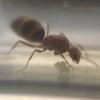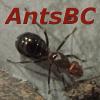1. Location of collection (ie: park/area, city/town, state/province, country). You can be more specific here than in the title, but please include the information in the title here as well. On a pillar for a strip mall. in Martin county, Florida (south Florida)
2. Date of collection (more important for ID's of queens).6/15/2018
3. Habitat of collection (ie: desert scrub, oak forest, riparian, etc.)strip mall in a busy town
4. Length (to the nearest millimeter or 1/16th of an inch.) Millimeters is preferred. Length is measured from the tip of the head to the tip of the gaster, excluding antennae, legs and stingers. Do not estimate, use a ruler! No matter how good you think you are at guessing the length of something, it's amazing how far off you can be sometimes.12mm (about)
5. Coloration, hue, pattern and texture (ie: dark redish-orange head, velvet-like gaster, translucent, hairy/bald, shiny/dull, etc.). Be as specific as possible, and you can use the diagram below if you need it.She appears to be dark dark brown, with a light brown underside
6. Distinguishing characteristics (ie: one petiole node/two petiole nodes, length and orientation of any spines or bumps on the thorax or waist, head shape, eye size, shape of mandibles, number of antennal segments, etc.) I'm too ignorant to see anything distinctive.
7. Anything else distinctive (ie: odor, behavior, characteristics relative to others in the colony, etc.). This is the only species and day that i have found a male ant, don't know if that helps
8. Nest description (if you can find the nest, and you're sure it belongs to the ant you collected) (ie: rotted log, volcano-shaped mound of coarse gavel 10cm in diameter, etc.).Unknown
9. Nuptial flight time and date (if you witnessed the ant or it's colony having a nuptial flight or caught an alate you are confident was flying that day or time)I don't know, but i found both this queen and a male both about 4:30PM
The Male


The Queen






















